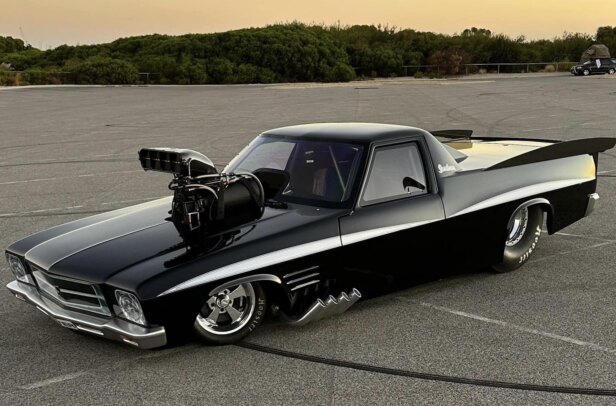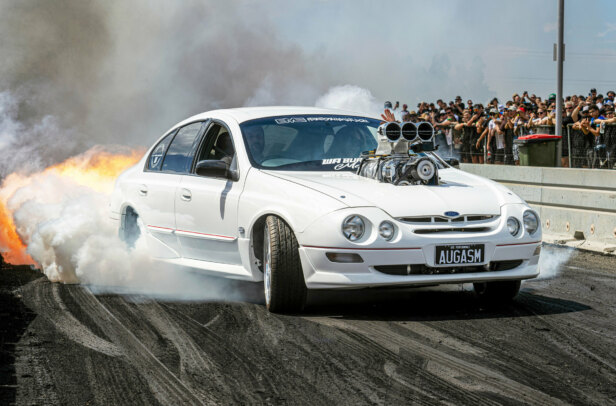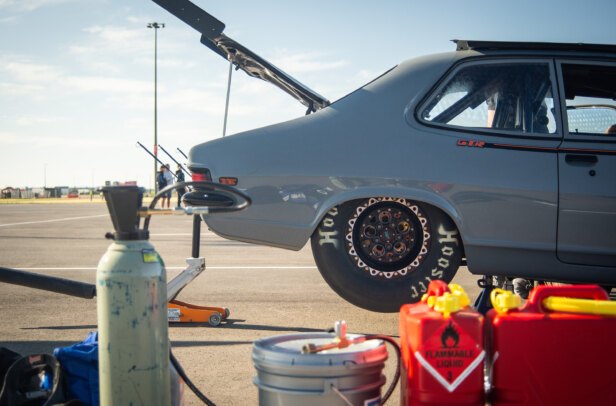The story of Boris Pacey’s HQ Sandman Doorslammer took quite a few twists and turns along its 15-year journey to completion, but when the covers came off at Motorvation 38, the wait and all the effort was rewarded handsomely. Not only did the car pick up a few trophies – most significantly People’s Choice – but it also broke the internet and had people talking for weeks. And while we don’t tend to feature many race cars, this one stands out for a couple of reasons.
First published in the May 2024 issue of Street Machine

Firstly, it’s a beautifully presented car with some genuinely mind-blowing fabrication, created in a backyard shed. Okay, the shed might be a bit bigger than average, and it does have a full-on spray booth in it, but it’s still in Boris’s backyard. Secondly, it’s got a great yarn behind it about an owner with a long and very productive history in street machining.
The inspiration behind this build was Boris’s first car: a black HQ ute he bought from his dad, who was a tow truck driver. The elder Pacey bought the ute as a write-off after the front had been smashed in and bought a set of brand-new GTS guards and a Statesman grille to get it back on the road. Boris paid his dad $2600 for it and sold it a few years later for a tidy profit, but always regretted letting it go, as he relates. “I kept telling myself, ‘One day I’m going to build a black ute and it’s going to be bigger and better than all the other ones.’” Well, you can’t argue that he isn’t a man of his word!

The genesis of this build came over 15 years ago, when Boris bought a tubbed One Tonner from legendary West Aussie drag-racer Anthony Begley. “It had a mild steel chassis set up for drag racing,” Boris says. “I made a fibreglass ute back end for it [separate to the body like a late-model Falcon ute’s], and it was basically a tub with big wheels in it and no tray. Then we found out from John Zappia that it was too long and had to be 115in, so that’s why we changed it back to a ute.”
Plans were initially to build two cars: one would race in Supercharged Outlaws and the other would be for burnouts. “That’s why I bought two of everything, and why it’s taken so long to get to this stage,” Boris says. “I’d buy a set of rims and then get a set for the other car.” That plan didn’t eventuate, but on the upside, Boris now has at least one spare of everything – in some cases, two.


RIGHT: Boris didn’t want an exposed rollcage, hence the fairing that runs off the back of the cab. He’s hoping the ute top will be filled with supporters’ names sourced through a sponsor website. Of course, he’d also be happy with a big corporate sponsor down the side!
Boris was keen on the idea of running a 6/71-blown 308 for Outlaws, but the Chapman Bros – who Boris helped when they were building their race cars – advised him against it. “They said, ‘Your 308 isn’t going to last; it’s going to blow apart, so why don’t you put a big-block in it?’” Boris recounts. “I figured if I’m going to put a big-block in it, I’m going to do a Hemi.”
It’s a beautifully presented car with some mind-blowing fabrication, created in a backyard shed
Boris bumped into John Zappia one day, who of course has been playing with Hemis in HQs for a long time, and it snowballed from there. Once the Hemi decision was made, Boris decided he would build the car for the Top Doorslammer class and spent the next six or seven years hanging out with and crewing for Zap. No doubt, that experience will help immensely when it comes time to get the Sandman down the track.




FRONT CLIP (above): The only real concession to aerodynamics is the flat front end. Boris built a front with a recess for a stock grille, but on a race car you need all the space you can get. The bumper is stock, which again isn’t ideal for aero
The original mild-steel chassis is long gone, replaced by a current Doorslammer-spec chromoly unit built by a local chassis builder and modified as the project evolved and parts were changed. One example is the diff, which is a massive Mark Williams modular 12in. “This diff will go 600 runs without breaking,” Boris says. “I had a sheetmetal nine-inch in it at first, so that meant we had to cut the whole back-half of the chassis off and start again.”
Boris’s aim is to make the car as low-maintenance as he can, with the smallest-possible crew
Before the chassis could be completed, Boris had to construct the body to ensure the ’cage and chassis components would all fit inside, as this wasn’t an off-the-shelf body you could simply order a chassis for. “To make the body you’ve got to build a plug first, and you’ve got to make that a perfect car,” Boris explains. “Shiny, finished, with all the body lines, gapped and everything. From that, you make a mould, and the plug gets thrown away.”



While this body can easily be lifted off by a couple of people, it still weighs around 120kg, which is comparatively heavy for a race car body. For example, Tim McAmis lists a fibreglass ’53 Corvette body at just 54kg, and a lightweight carbonfibre version at just 26kg! Boris admits he went a bit heavy with the reinforcing to make sure it didn’t flop around when the chassis builder was handling it, so it’s heavier than it should be, but it sure looks nice. Boris has worked on many fibreglass boats, so the body came out of the mould so nice that he could have polished up the joints, buffed up the black gelcoat, and sent it. Of course, a gelcoat finish was never going to be on the cards, as among his many talents is the ability to lay down a pretty good paint job.
Things have certainly stepped up from when Boris was thinking about running a blown Holden in Outlaws. The solid-billet Brad Anderson Hemi block is topped with billet BAE-6 heads and filled with a forged rotating assembly consisting of a Bryant crank, GRP rods and Carrillo pistons. The valvetrain is from Manton and controls the 2.40in intake and 1.90in exhaust valves after they get their instructions from the Crane mechanical roller cam. Fed by a massive PSI 206D screw blower topped with a Jeff Burnett carbonfibre hat and a fuel system designed by Greg Gower, the engine will need to – and should – make between 2500 and 3000hp to run in the 5.80s. As Boris puts it, that’ll let him play with everyone.


Backing up the engine is a B&J three-speed with a Ty-Drive converter drive to control the Neal Chance lock-up converter, which is housed in a Bohr Racing titanium bellhousing. The car was initially built with a clutch, but Boris’s aim is to make the car as low-maintenance as he can with the smallest-possible crew. The next step towards that will be changing the bellhousing and mounting an onboard starter motor. It might not lead to a one-man race team, but it should be pretty lean.
While a lot of people can’t believe he’ll actually race the car because it’s so nice, Boris is adamant that it will hit the track in the upcoming 2024/25 season. “The first year will be a lot of suspension tuning and working stuff out,” he says. “The power side isn’t a problem – it’s getting it to run straight that’s important. I spent 15 years building the car to perfection and it might take me two years to build the speed to perfection, but I’ve got the patience to do that.”



DRIVELINE: The transmission is a B&J three-speed attached to a Ty-Drive converter drive, which controls the Neal Chance lock-up converter. Above that are the eight MSD coil packs which replace the magneto
We’re keen to see that when it happens, and who knows? We might even see the Sandman line up against the legendary Zap’s Rat in a final one day. What a sight that would be!

SEE MORE!
If you want to see a whole heap of build photos and videos, check out @dragsandman on Instagram and Borcraft Industries on Facebook.
BORIS PACEY
1974 HQ HOLDEN DOORSLAMMER
| Paint: | Black with silver Sandman decals |
| DONK | |
| Type: | 491ci BAE Hemi |
| Induction: | Jeff Burnett carbonfibre hat |
| Blower: | PSI-D |
| Heads: | BAE-6, Victory 2.40in (int), 1.90in (exh) valves |
| Cam: | Crane mechanical roller |
| Pistons: | Carrillo |
| Crank: | Bryant |
| Conrods: | GRP |
| Exhaust: | Adjustable zoomies |
| Ignition: | MSD PRO 600 CDI |
| SHIFT | |
| Gearbox: | B&J three-speed with Ty-Drive, BOHR Racing Products titanium bellhousing |
| Converter: | Neal Chance lock-up |
| Diff: | Mark Williams modular 12in, 40-spline axles, 4.26 gears |
| BENEATH | |
| Suspension: | Tubular IFS, Strange Ultra struts (f), Menscer coil-over (r) |
| Steering: | Stiletto rack-and-pinion |
| Brakes: | Strange; two-piston calipers and carbon-fibre discs (f), four-piston calipers and carbonfibre discs (r) |
| ROLLING STOCK | |
| Rims: | Mickey Thompson; spindle-mount 15×3.5 (f), Pro 5 ET Drag 16×16 (r) |
| Rubber: | Hoosier; 23×5-15 (f), 17×36-16 (r) |
THANKS
My wife Lisa for putting up with all the late nights and dodgy costing on parts; my son James Pacey at Jampac Fabs for great fabrication, TIG welding, sheetmetal and general help; Gerry Andrijich for his help from day one; Josh Lawson at Promarine Fremantle for helping out every week for the last six years; Jeff Cutajar at JC Race Stuff for wiring up the car and organising the latest race parts; Joel Eddleston at MP Media; George Separovich at Blown Motorsports for being our trusted engine builder; Joe Latham at ProWest Engineering for his help with all of our CNC work



Comments